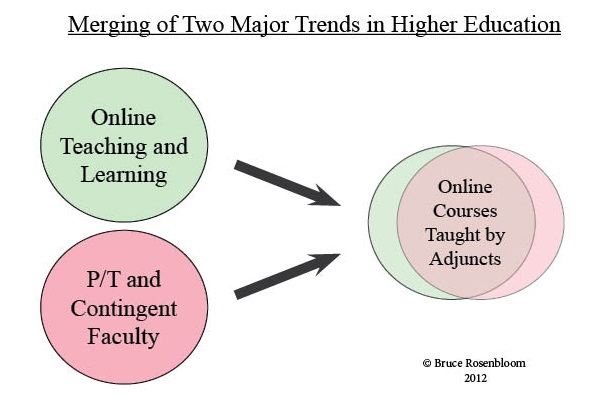Reading this week’s Chronicle article entitled, “Adjuncts Build Strength in Numbers: A New Majority Generates a Shift in Academic Culture,” I had an epiphany. The rise of online learning, in all likelihood the major trend in higher education in the past two decades, has occurred during the same period when adjunct instructors in colleges have grown very rapidly. Is there any connection?
The Chronicle article states the alarming statistic that “about 70% of instructional faculty at all colleges are off the tenure track,” with even more dramatic numbers in community colleges and “mid-tier private and regional colleges.” Not all of these adjuncts are part-timers teaching a course or two, but instead, have full-time jobs for a contractual period of 3-5 years. When that period is up, there is no guarantee of continuing employment. It is obvious why administrators would favor such arrangements–they allow for reduced costs and greater flexibility in hiring and firing of faculty. So, for example, if a college needs a professor to teach computer graphics instead of philosophy (not to pick on that discipline), they may hire the expert on demand rather than be stuck with a tenured professor with a small (not cost-effective) class.
The Chronicle article goes on to argue that hiring all these adjuncts is not sustainable given that committee work and service needs cannot be easily assumed by adjuncts, and so something has to give. In reality, the cost structure of most institutions makes a diminished tenured professoriate only sustainable by increasing numbers of part-time and contingent faculty. In essence, adjuncts, who often teach half of the courses in many departments, are subsidizing the perks of the tenured class of instructors. It is my belief, that it is the tenured professoriate that is not sustainable, which is exactly what is driving the trend toward adjunct instructors. Calls for accountability and productivity by state legislatures funding public institutions, have increasingly been more skeptical of lifetime employment and other perks that come along with tenure. To the extent that institutions have the leeway to move away from those old structures, they are often exercising those options.
The impetus for online comes from different roots. Online has only reached a critical mass in the past decade with the advent of ubiquitous online technologies. I remember in the early 1980s co-publishing several papers on what was then called “Computer-Assisted Instruction,” (CAI). I was very impressed with how these early machines might be used to advance teaching and learning, particularly for rote learning exercises. Nonetheless, although the marriage of education and technology has a long history, it is only recently due to these advancements that online has hit its stride. The array of tools that can now be used in an online class would be inconceivable to those pioneers working on the early incarnations of computers for educational purposes.
There are many forces driving online learning today, particularly scheduling flexibility, instructional quality, convenience, cost-savings, and less need to build more “brick and mortar” facilities. Even so, I feel there is an overlap between these two trends of rising adjunct employment and online learning (see diagram below).
As online gains greater acceptance and enters the instructional mainstream, institutions see online as critical to their strategic planning in terms of flexible program offerings, new student recruitment, cost-savings, space utilization and other factors. The key point here is that more and more, these online courses are taught by part-time faculty. So what was two independent trends are now reinforcing each other and merging into the major trend in higher education: online courses taught by a contingent workforce. I see no counter-trend to this happening and, in fact, MOOCs and other technologies will continue to result in what I term the “dis-aggregated professor” in a previous blog post.
References:
June, A. W. (November 9, 2012). “Adjuncts Build Strength in Numbers,” The Chronicle of Higher Education. Retrieved from: http://chronicle.com/article/Adjuncts-Build-Strength-in/135520/
June, A. W. (September 7, 2012). “How Colleges Treat Adjuncts Limit Their Effectiveness in Class,” The Chronicle of Higher Education. Retrieved from: http://chronicle.com/article/Adjuncts-Working-Conditions/133918/
Rosenbloom, Bruce (February 16, 2012), “The Dis-Agregated Professor,” CUNY Academic Commons. Retrieved from: https://onlinelearning.commons.gc.cuny.edu/2011/08/13/the-disaggregated-professor/
Graphic Designed by Fulya Olgac



